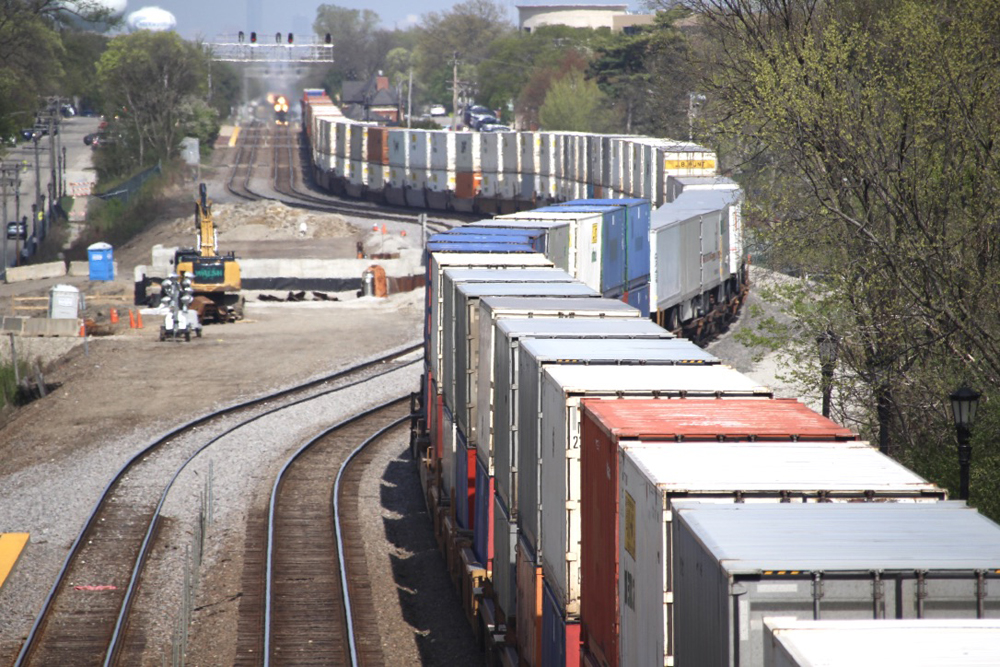
Rail traffic is expected to have another tough year as intermodal, carload, and coal traffic will all struggle to show growth.
That’s the view of Todd Tranausky, vice president of rail and intermodal at freight forecasting firm FTR Transportation Intelligence.
North American rail traffic was down 1.9% overall last year, according to the Association of American Railroads.

International and domestic intermodal aren’t likely to grow this year as imports are down, rail service hasn’t fully recovered from the impact of ongoing crew shortages, and rates are not competitive with trucks, Tranausky said on a webcast today.
Compared to its five-year volume average, intermodal traffic has slumped for most of the past 18 months, Tranausky noted.
Congestion at labor uncertainty at West Coast ports has prompted shippers to seek alternatives on the East Coast and Gulf Coast, which are less friendly for intermodal moves because of the relatively short length of haul.
The congestion is gone at West Coast ports, but shippers are unlikely to shift volumes back until a new labor agreement is reached, Tranausky says. And the longer labor negotiations drag on the less likely it is that shippers will divert all of their volume back to the West Coast, he says.
Overall carload traffic is expected to be flat this year, Tranausky says, as a slowing economy will reduce freight demand. When coal, agriculture, and petroleum products are stripped out of the mix, however, the remaining carload segments may grow by 1% to 3%.
“It’s not gangbusters growth,” Tranausky says.
Coal traffic was up 3.3% last year as a surge in natural gas prices prompted utilities to burn cheaper coal. That trend won’t continue, Tranausky says, because of the scheduled retirement of coal-fired power plants this year, which will permanently reduce the market for thermal coal.
A wildcard for railroad volume remains how quickly railroads can reach full train and engine crew staffing levels and return service to normal levels, Tranausky says.
The U.S. railroads are not yet back to pre-pandemic employment levels, Tranausky notes, and average train speeds were below their five-year average throughout 2022.
A bright spot was an improvement in average train speed in the fourth quarter. But Tranausky says a threat to continued improvement is the potential for engineers and conductors to pocket their back pay and bonuses from the new labor agreement and then quit. That would put railroads back into deeper crew deficits, which would hurt service and rail volume, Tranausky says.














I still say go back to 75- 100 car trains with only 2-3 engines only not these 200 car trains or better , the reasons are they run faster, it doesn’t take hours to put a train together in the Yards and they will fit in the yards when they get to their final destination , not waiting outside of the yards for Hours or even Days cause they don’t fit , you are also wasting fuel when you have to use 5,or 6 or even 7 engines per train . The shorter trains are more economy friendly simply put.
Service appears so bad shippers are looking for anything but rail to move things.
I happen to know quite a few “engineers and train men who will pocket their back pay and quit”. The RR’s never addressed “quality of life” issues, nor were the raises enough to fight the crazy high inflation, and definitely not enough of an incentive to stay on for many, therefore guys have looked elsewhere. What’s incredible is the amount of coworkers with 10+ year’s in who are quitting. I’ve never seen so much seniority walk away. Normally, if you make it 5 year’s, 90% of those will become career men/women. That’s not the case any more. Railroad management has made it so miserable out here that guys with 10, 15, even 20 year’s are walking away to go work linemen, healthcare, trucking, and long shoreman job’s, just to name a few of the job’s I’ve seen guys leave for. The morale is the worst it’s been in the 15 year’s I’ve worked out here. Where I work, their offering 5K – 15K bonuses to lure new hires and paying 20K to guys who can retire to stay on a year, meantime, they cut virtually EVERY agreement violation claim and chase guys in the middle of their careers right out the door. Maybe if they concerned themselves with their current employees, they wouldn’t need these new hire and retirement bonuses. I don’t understand their business plan. It makes absolutely no sense. Just compare what Delta recently offered their pilots for a contract, who are also subject to the RLA (railway labor act). I’m not looking to compare overall pay, simply the percentages. If the railroads had offered similar percentages and ack pay, they would not be in this mess. I guarantee it.
Railroads are in the midst of a terminal disease MBAitis. Cut costs on the people who do the work so that senior management can pay itself (and the directors) fat salaries plus bonuses by keeping the stock price high. It’s a winning formula that has worked so well for US manufacturing. (not to mention what it’s done to politics).
EXACTLY Drew. See my screed about remote controls switching and the Union Pacific GE SLEDS. Make everything and everyone miserable and wonder why they walk away.
Back is the day (yes, I’m going there) it was usually a fun job, interesting and even exciting. Not every day mind you but I enjoyed the place immensely and was looking forward to railroad retirement. (Got there in 2014). The men and women I worked for and with added to the enjoyment for the most part.
Now no one looks forward far enough to even see retirement (you WILL get there I guarantee). The days of old are gone and when da boss is using a remote controlled drone to watch your work, your rewards are few and even the pay, while FANTASTIC becomes just cash in your hand and the Thrill Is Gone. Most everyone is miserable and even going to union meetings isn’t fun anymore.
Oh well. Make hay while the sun shines I guess and hand the mrs. the check and wave goodbye.
And that’s why you shouldn’t rely on making short term profits for long term growth and profits.